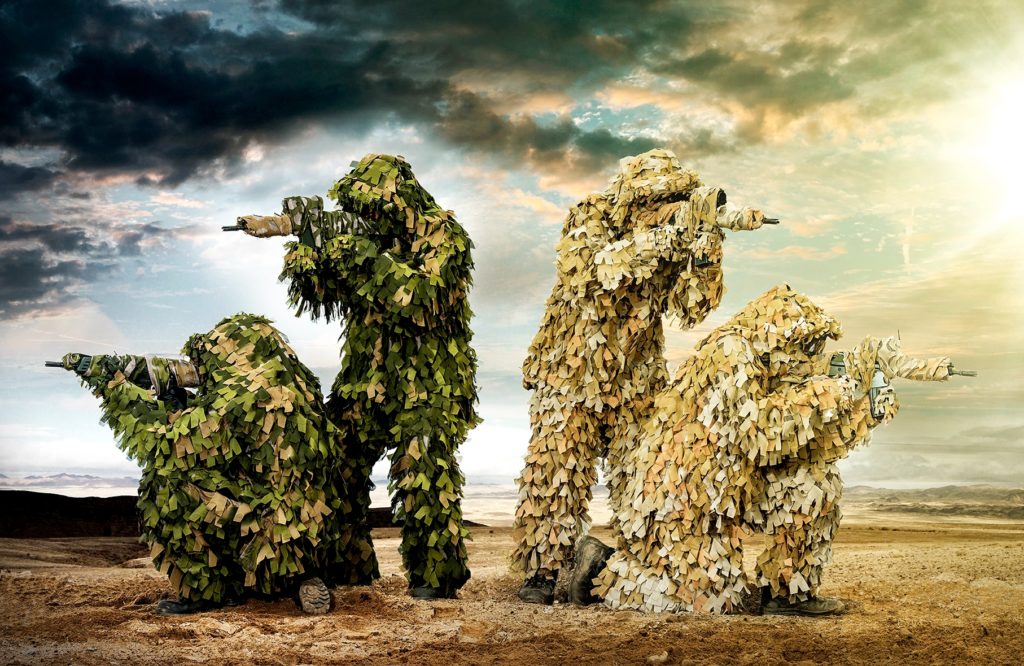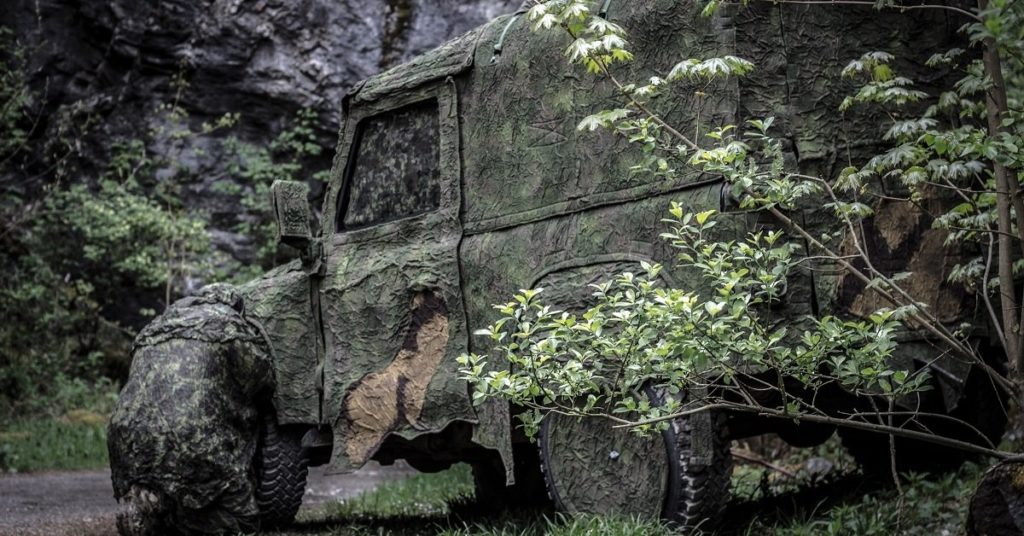Protecting the military today requires sophisticated, multifaceted camouflage solutions.
by Marie O’Mahony

New fabric developments in camouflage, as well as innovative design approaches, are taking textiles to another level of protection for military applications. In recent years, a great deal of discussion has been given to digital camouflage and its perceived success or failure. While that particular debate shows little sign of abating, there is a growing recognition that camouflage has to offer a more comprehensive suite of protection for the wearer.
The latest developments are setting the pace for the next generation of military camouflage as they incorporate additional levels of protection against fire, ballistics, infrared radiation (IR), thermal conditions and counter-radar detection.
Building the fabric
British manufacturer Heathcoat Fabrics have developed a camouflage fabric that is made from 100 percent aramid fiber for heat and flame protection. Praetor-FR is a Disruptive Pattern Material (DPM) that is Infrared Reflective (IRR) coated to a high level of durability. A recent article in Light: Science & Applications(April 6, 2018) identifies the challenge of combining high reflectivity with durability, particularly in use where they can be exposed to environmental hazards such as “dust, windblown sand, moisture, acid rain and salt fog.”
According to Heathcoat, traditional processes that use a cellulosic component in the printing can compromise fabric durability so that the use of the aramid makes for a more stable fabric. Mark Drysdale, commercial manager with Heathcoat Fabrics is enthusiastic about the benefits. “We have received outstanding test results to confirm Praetot-FR has outperformed traditional fabrics in the market,” he says. “It shows higher tenacity, increased breathability, no afterglow and most importantly higher durability—all of which has been combined into a lighter weight fabric.”
TenCate Protective Fabrics in the U.S. has developed several camouflage fabrics that offer heat protection. The company was one of the first to successfully dye the signature bright yellow aramid fabrics without compromising their inherent strength. Their Aramid Camouflage offers flame as well as ballistic protection.
TenCate Commando is a ripstop weave with FR nylon, Lyocell and Modacrylic yarns. It is designed to offer protection in tropical climates. Active moisture wicking in Coolderm technology brings wearer comfort and adds to their performance, with moisture drawn away from the body to the exterior of the fabric.
Protective military fabrics are not normally associated with sustainable yarns, so it is interesting to see the use of Lyocell in this American manufactured fabric. TenCate Defender M is a lightweight camouflage that also focuses on comfort and versatility of use across a variety of climates. It is available in a range of weaves, knits and laminates.
The collection includes Defender M 11000 using Coolderm technology with a Rainshield laminate, stretch and FR technologies. Defender M550 StaticShield contains an additional anti-static yarn to help protect against unpredictable challenges when dealing with chemicals or other combustible materials with inherent dangers of flame, sparks or electrostatic discharge.

Seeing camouflage differently
Background matching, disruptive pattern and mimicking irrelevant objects (masquerade) were the three forms of camouflage under consideration; all focused on visual recognition. The research showed that while background matching and disruptive pattern were not successful once the subject is in motion, masquerade through the use of ‘distractors’ in the form of moving elements in the background, for instance, could slow the recognition process by as much as 70 percent: the more distracters, the greater the delay.
Advances in sensors and advanced imaging techniques are offering protection on the one hand, but they are also creating additional threats that military fabrics have to provide protection against. Ceno Technologies, Buffalo, N.Y., produces low-observable coatings comprised of cenospheres, microspheres or flecks designed to make IR detection more difficult.
Cenospheresuse a wet chemistry technique to apply a thin coating of silver to allow the finished product to perform like silver in electrical conduction and IR. Hollow glass microspheres are also referred to as microballoons and glass bubbles. They have diameters ranging from 10–300 micrometers coated with silver that are found to absorb electromagnetic energy instead of simply reflecting it.
Aluminium or mica flecks can be coated with a choice of precious metals to produce highly reflective materials with the conductivity of the precious metals that can absorb electromagnetic energy. Lightweight camouflage nets can incorporate radar absorbing or radar scattering materials weighing as little as 20 grams-per-square-foot, and allowing light and air to penetrate through the open structure.
Versatility counts
FibroTex develops and manufactures its Signature Management Systems to function in a range of environments from the Arctic to deserts, woodland and urban. The company is supplying the U.S. Army with the Next-Generation Ultra-Light Camouflage Netting System (ULCANS) following a two-year test period. The multispectral camouflage offers protection from IR, thermal and counter-radar threats, and it comes in a reversible design with different patterns and capabilities on each side.
“Today more than ever, military forces and opposition groups are using night vision sensors and thermal devices against our troops,” according to Eyal Malleron, CEO at FibroTex. “But by using [our] camouflage, concealment and deception solutions, we make them undetectable again; allowing them to continue keeping us safe and save lives.”
The company offers similar protection for the individual soldier in their dual-sided personal two-dimensional multispectral camouflage suit designed for any terrain. Weighing less than 2Kg, it offers significant heat reduction and is fire retardant.
Saab, headquartered in Sweden, has its Barracuda’s Mobile Camouflage System that offers multispectral protection for vehicles, whether static or in motion. The Ultra-Lightweight Camouflage Screen (ULCAS) is an advanced multispectral net for protection against reconnaissance and sensors operating in relevant parts of the electromagnetic spectrum.
The hot surface and large radar cross-sections make vehicles vulnerable to sensor and target acquisition systems. Saab’s Signature Management Systems includes a HeaT Reduction CoolCam to reduce heat penetration, with a lightweight deployable Shading Umbrella to obstruct thermal and visual reconnaissance. Its Ballistic Protection System provides improved blast and shrapnel protection, comprised of layered aramid, foam and signature management material. The Vehicle Load Carriage System offers additional storage and pouches on the exterior of the vehicle for ease of access.
Developing camouflage for known challenges is a given, but as modern warfare dictates, textile manufacturers must now plan for the unknowable as well. The rules of engagement have changed and the industry is responding to the challenge.
Marie O’Mahony is an industry consultant, author and academic. She the author of several books on advanced and smart textiles published by Thames and Hudson and Visiting Professor at the Royal College of Art (RCA), London.
 TEXTILES.ORG
TEXTILES.ORG


